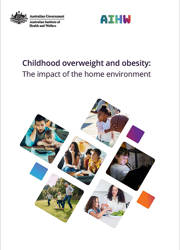Summary
Childhood overweight and obesity is a major public health issue in Australia. In 2017–18, 1 in 4 (25%) children and adolescents aged 2–17 were overweight or obese, and about 1 in 12 (8.2%) were obese. Overweight and obesity in children is associated with a significant risk of developing chronic diseases, as well as remaining overweight or obese as an adult, which further adds to the risk of disease.
Overweight and obesity is mainly caused by an energy imbalance (where too much energy is taken in through food and drink, and not enough energy is expended through physical activity). But many different interconnected factors drive this energy imbalance, making overweight and obesity complex to address.
This report aims to provide a resource to inform overweight and obesity prevention strategies and policies for children and their families. It looks at the individual and family factors in the home environment – where a child lives and grows – that affect childhood overweight and obesity. These factors, along with broader community and society influences, affect a child’s likelihood of becoming overweight or obese.
Individual factors
Individual factors are those that vary between children living within the same household.
A child’s first 1,000 days – that is, from conception until the age of 2 – is a particularly important period for their body’s development.
Many factors in the home environment influence overweight and obesity, including:
- breastfeeding
- eating a healthy diet with age-appropriate meal sizes
- activities children do throughout the day – getting the right balance of sleep, physical activity and sedentary behaviour in a 24-hour period
- whether a child has a disability
- self-esteem
- mental health.
Family and community factors
Family and community factors are those that all children in a household experience. Most children, particularly pre-adolescents, depend on their parents and carers for food, transport and care. Therefore, factors affecting parents and carers (such as local amenities, food costs, stress, packaging and marketing of foods) will affect how parents and carers provide food and activities.
Family habits play an important role in overweight and obesity. The underlying attitudes and beliefs of parents and carers influence their parenting style. This includes the rules and expectations they use to influence children’s behaviour within the home (for example, demonstrating and encouraging positive attitudes and healthy behaviours around food and exercise, eating meals together and screen time limitations).
Siblings and other family members also play a key role, by encouraging physical activity through play, and demonstrating and encouraging positive attitudes and healthy behaviours.
The environment where a home is situated can affect the types of foods and activities available to children. Having access to healthy food options, as well as a local area where people can use active transport and easily get to parks and amenities, all support a healthy lifestyle for children and their families and reduce the risk of overweight and obesity.
What can be done about childhood overweight and obesity?
Many evidence-based actions can help address childhood overweight and obesity.
Reviewing the literature on overweight and obesity can identify patterns and trends, to help Australian policymakers develop and improve national prevention strategies.
Some examples of these strategies include the:
- National Obesity Prevention Strategy
- National Preventive Health Strategy
- review of the Australian Dietary Guidelines.
These initiatives aim to find ways to help Australians live healthier by eating healthier food, drinking healthier drinks and doing more physical activity.
Summary
1. Introduction
- Obesity and the home environment
- Family influences affect childhood health and wellbeing
- Community, society and socioeconomic circumstances influence the home environment
2. Individual factors in the home environment
- Preconception, pregnancy and birth
- Breastfeeding
- Food intake
- Physical activity
- Sedentary behaviour and screen time
- Sleep
- Disability
- Self-esteem and mental health
3. Family and home environment surroundings
- Habits
- Family meals and eating behaviours
- Convenience and discretionary foods
- Food cost
- Packaging and marketing
- Food environment
- Home and neighbourhood physical environment
- Home environment stressors
4. What can be done about childhood overweight and obesity?
- Current government initiatives
- Actions to address childhood overweight and obesity
End matter: Acknowledgments; Glossary; References; List of boxes; Related publications



